- News
- Reviews
- Bikes
- Accessories
- Accessories - misc
- Computer mounts
- Bags
- Bar ends
- Bike bags & cases
- Bottle cages
- Bottles
- Cameras
- Car racks
- Child seats
- Computers
- Glasses
- GPS units
- Helmets
- Lights - front
- Lights - rear
- Lights - sets
- Locks
- Mirrors
- Mudguards
- Racks
- Pumps & CO2 inflators
- Puncture kits
- Reflectives
- Smart watches
- Stands and racks
- Trailers
- Clothing
- Components
- Bar tape & grips
- Bottom brackets
- Brake & gear cables
- Brake & STI levers
- Brake pads & spares
- Brakes
- Cassettes & freewheels
- Chains
- Chainsets & chainrings
- Derailleurs - front
- Derailleurs - rear
- Forks
- Gear levers & shifters
- Groupsets
- Handlebars & extensions
- Headsets
- Hubs
- Inner tubes
- Pedals
- Quick releases & skewers
- Saddles
- Seatposts
- Stems
- Wheels
- Tyres
- Health, fitness and nutrition
- Tools and workshop
- Miscellaneous
- Tubeless valves
- Buyers Guides
- Features
- Forum
- Recommends
- Podcast
news
Bike shorts in January? Cold cycle lane clip sparks clothing debate amid motorist meltdown over “Lycra clad speedsters” riding in “wrong lane”; London “world’s slowest city for drivers” study slammed; “Disrespectful” cyclotourists + more on the live blog
SUMMARY
 Cycleway 4 in January (Greenwich Cyclists, Twitter)
Cycleway 4 in January (Greenwich Cyclists, Twitter)10 January 2024, 09:08
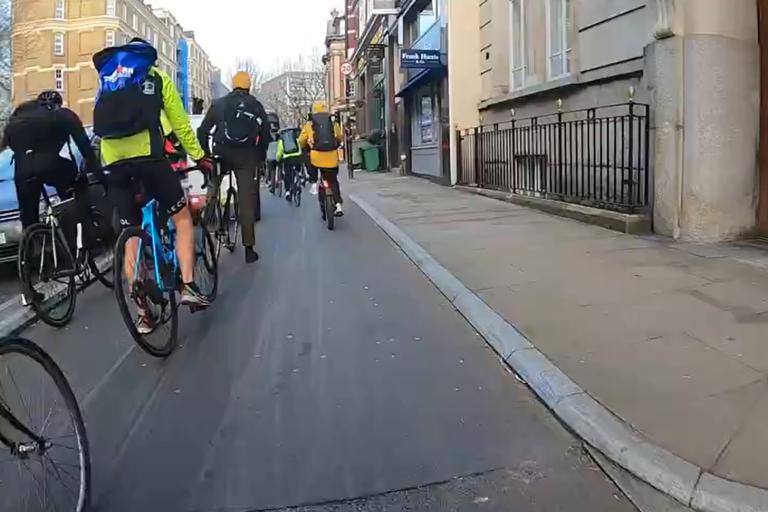
Bike shorts in January: A good idea? Cyclists debate January clothing choices in cold cycle lane clip – while motorists have meltdown over ‘dark’ cycling kit and overtaking riders in “wrong lane”
To layer up, or not to layer up, that was the question raised by a brief clip of yesterday’s morning commute on London’s Cycleway 4, thanks to the presence of a tough/foolhardy [delete as appropriate] cyclist making his way to work with his knees firmly on show as the temperature barely nudged above zero.
With the mercury rapidly plummeting this week, the clothing choices of the cyclists around us can certainly divide opinion.
And while we’ll never tell you what to wear while on your bike (it’s up to you at the end of the day), I’ve always been in the ‘more layers the better’ camp – and, in my wilder, youthful days, have been known to express derision towards the ‘hard men’ in the group ride steadfastly intent on donning shorts as ice glints in the background (wearing shorts throughout winter is not a personality trait, alright?).
Cycleway 4 this morning. Bit nippy at 2C. Kudos to the guy in shorts 🥶 pic.twitter.com/AWrK9F5ctw
— Greenwich Cyclists (@GreenwichCycle) January 9, 2024
Anyway, off my soapbox I go, and back to Greenwich Cyclists’ clip, which the OP captioned with “Bit nippy at 2C. Kudos to the guy in shorts.”
Others, such as Clare, were also impressed by our Le Col shorts-sporting friend’s attire:
Chapeau to the shorts guy. Serious effort that. pic.twitter.com/kp7K8Obs8o
— Clare McMenemy (@highpoh) January 9, 2024
And Pablo even said he “saw a guy in a t-shirt on his bike today”. I’m cold just thinking about it.
However, others weren’t as impressed. “Saw two or three in shorts on my way in this morning. Far too cold for me to be doing the same!” wrote Clarissa.
“Yes and, er, no,” road safety guru Bob Davis replied. “The only people I have known who went out with uncovered knees at temperatures below 5 Centigrade developed knee problems.”
“Steep learning curve for a few gloveless Lime users yesterday,” added Guido.
2C? It was -8C here this morning. My Shimano hub gears had frozen, I only had 1st gear & the onboard computer controls also solid (water from rain last 3 weeks behind buttons) - bike thawing out in the office.
— David Wright 🐧😈🤦♂️😎 (@wright_de) January 9, 2024
However, since the clip was posted on Twitter, we also had the usual hordes of commenters moving the conversation away from the important stuff – like whether shorts in winter is a good idea – and criticising instead the cycling on display on Cycleway 4.
“Oh yes indeed passing the cyclists decked out in black, they’ll be finishing work before it gets dark,” Nigel chipped in with the obligatory dark clothing remark.
Meanwhile, most of the other anti-cycling snoopers were intent on criticising the decision by a number of the riders to overtake the FedEx delivery cyclist.
“Why are cyclists riding on the wrong side of the cycle way? Cyclists coming the other way (correctly) had to move out of the way,” said Tony.
“Is that bad cycling in an oncoming cycle lane?” asked Ian, while Oliver wrote: “Some pretty impatient cyclists there including the camera crossing hard white going on the wrong side and almost clipping oncoming just to get a few yards ahead.”
Looks safe and considerate pic.twitter.com/d46u2jX1rY
— Mr Biggun (@Mr_Biggun_) January 9, 2024
“And ‘kudos’ to you for showing all the cyclists who don’t know how to ride on the left of a two-way bike lane, but would scream if a car did the same thing,” added Xuan.
“Look at how they use their own cycle lines,” said Lucian (and I assume he meant ‘lanes’). “Close passes, dangerous overtaking, inconsiderate, wrong side, almost head-on collision. Then they take this onto the real roads and always claim that it’s the motorists that are the danger.”
Finally, the very observant Ged wrote: “If car drivers are supposed to give cyclists 1.5 metres when they pass so the cyclist feels safe, shouldn’t cyclists also give 1.5 metres? I think if I was out cycling and one the lycra clad speedsters hurled past me too close I would feel very unsafe.”
Yes, because those two things are exactly the same… Can’t we just have a nice debate about cycling shorts for once?
10 January 2024, 16:58
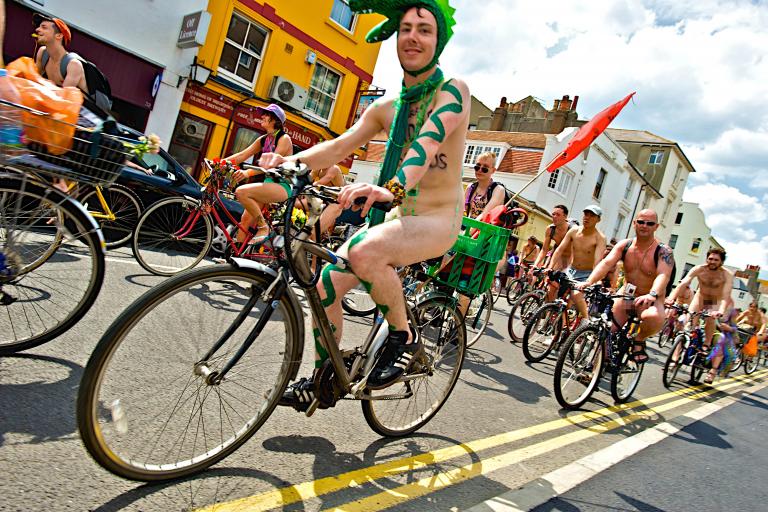
“People need to stop gatekeeping what others wear. They’re not your legs”: Reaction to the great shorts debate
Turns out people can get quite riled up by a tongue-in-cheek blog story about cyclists in shorts, can’t they? I know, I know, it’s the internet in 2024, I really should know better by now.
“People need to stop gatekeeping what others wear. If someone is comfortable in shorts then let it be. They’re not your legs,” Gaz wrote on Twitter, that renowned breeding ground of thoughtful, conscientious debate.
Even those bike riding naturists, the Free Wilders got involved, which was an interesting turn of events, to say the least. “We are cyclists and body freedom campaigners,” they said.
“Wear what you’re comfortable wearing and accept us when it’s warm and we wear nothing on our tandem bike.”
Fair point!
> Naked tandem couple hit by driver in Scotland make it to Land’s End
However, others were less concerned with gatekeeping and freedom of choice as they were about freezing tendons.
“Unlike muscles, tendons have no direct blood supply. In cold weather they can stretch and snap. Keep your knees warm,” said Adespoto.
Meanwhile, Robert Davis agreed with Gaz’s initial comment “in principle”, but added “I would note that the only people I have known who regularly did long rides in sub-five degrees with knees uncovered developed knee problems.
“A lot of newbies (blokes especially) are used to school football with shorts and think that’s the same with cycling, not realising that there is a thing called ‘wind chill’.”
In the blog comments section, IanMK said: “I was actually lectured on the subject of knee problems by an old pro I cycled with on a cold April morning. He actually said that just because it was spring didn’t mean that I should have my knees out on a ‘training ride’.
“He actually set the temp at 15°C. I did go and buy some knee warmers and I still pretty much stick to this advice.”
Ah, a knee! Put it away!
While brooksby brought up another potential issue related to clothing choice on the way to work: “Now the weather has (finally?) got cold, I've had my own sartorial problems. I had my heating fixed before Xmas, so my house is properly warm. And my office is properly warm. But the journey in between is bloody cold.
“Obviously I can take a layer off when I reach the office, but if I dress up for the journey I’m sweltering before I've left the house.”
And on Facebook, Igenlode had a similar problem: “I was out on Sunday and had to start stripping off as per usual once I hit the uphill – I'm currently cycling in shirtsleeves *under* a coat, with the option to open the coat/take off gloves in order to regulate body heat. With a heavy bicycle it's amazing how much sweat you can work up.”
Also, on Facebook, at least Dave took the story in the manner it was intended, writing “spot the northerner”.
Yes, that’s more like it.
Anyway, here’s the bottom line – wear whatever you want on your bike. Even wear nothing, if that’s what you fancy.
And never – ever – listen to some smartarse writing a tongue-in-cheek story on a cycling live blog…
10 January 2024, 12:09
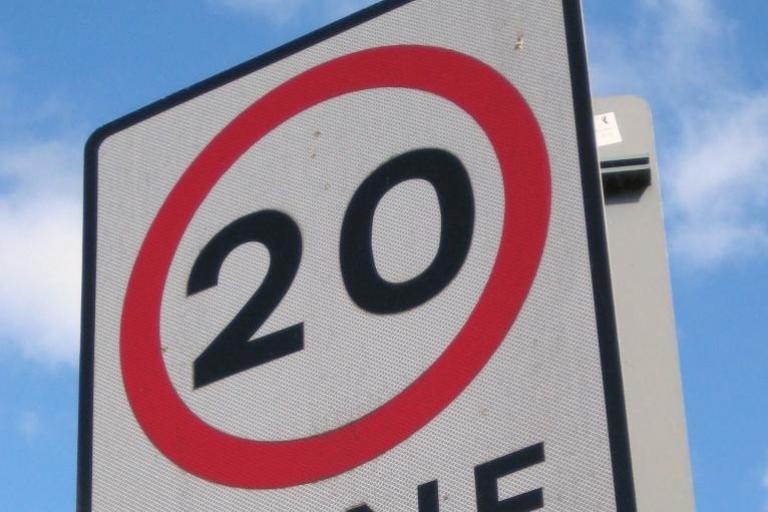
“Are TomTom really advocating for 50mph limits in built-up areas?” Study claiming London is the “world’s slowest city for drivers” slammed
A recent study from Sat Nav company TomTom – which claims that London is the world’s slowest city for drivers, apparently due to the widespread use of 20mph speed limits – has been fiercely criticised by active travel campaigners and politicians, who have branded the study’s findings “misleading” and “disingenuous”.
According to TomTom’s analysis, journeys of 10km in central London took an average of 37 minutes and 20 seconds last year, the longest time of the 387 cities, from 55 countries, assessed.
“London really is the slowest place in the world to drive a car,” TomTom’s Stephanie Leonard said.
“Especially in the core city centre, you don’t have maximum speed limits of 50mph or higher, it’s a maximum of 20mph. You don't have the infrastructure for driving very quickly.”
Ah yes, it’s the lack of 50mph speed limits that are the main reason everyone’s not buzzing around London in their cars. Makes sense…
Naturally, TomTom’s rather shaky analysis has been skewered by people who actually know a thing or two about what they’re talking about.
“It’s that time again when private traffic companies disingenuously mix up correlation and causation to secure headlines,” West Midlands Cycling and Walking Commissioner Adam Tranter tweeted this morning in response to the study.
“Are TomTom really advocating for 50mph limits in built-up areas? Consistently lower speeds aid traffic flow and reduce congestion. 20mph saves lives.”
Replying to Tranter’s tweet, Rebecca wrote: “It’s partly thanks to TomTom that every single side street and through road is now a dangerous ratrun. So TomTom can go twizzle on themselves.”
Meanwhile, a spokesperson for London mayor Sadiq Khan said: “This study is misleading as it only includes analysis from a very small part of the city centre, not the whole of London.
“Roadworks are the biggest cause of congestion in cities, which is why the mayor’s infrastructure co-ordination service is working with boroughs and utility companies to reduce delays caused by roadworks, helping to save London road users over 1,250 days of roadworks since 2019.”
“We disagree with this analysis of road speeds and believe it is not representative of London as a whole,” TfL's director of network management and resilience Carl Eddleston added.
“This report only looks at data collected up to 5km from the centre, regardless of the city’s overall size and density, which means that fair comparisons with other cities cannot be made.”
10 January 2024, 16:27
Mark Beaumont and Davy Zyw organise Edinburgh ride for Doddie Aid
If you’re knocking about the Scottish capital this weekend, make sure to pop down to Holyrood on Saturday at noon with your bike.
Because, as well as taking in the majestic scenery (and the not-so-majestic Scottish parliament), there you’ll be able to join round-the-world cyclist Mark Beaumont and author Davy Zyw for three fun laps around Arthur’s Seat – all in the name of Doddie Aid, a virtual mass-participation exercise event that kicked off on New Year’s Day and raises funds for the My Name’5 Doddie Foundation, the late Scottish rugby hero Doddie Weir’s motor neurone disease charity.
Saturday 13th at midday - muster at Holyrood car park, just off Queen’s drive with yer bikes for 3 laps of Arthur’s Seat - all miles, fundraising and smiles for @doddie_aid - with @DavyZyw and yours truly pic.twitter.com/3Ns2ij2yrN
— Mark Beaumont (@MrMarkBeaumont) January 10, 2024
Now that sounds like a great – and worthwhile – way to spend a weekend in Auld Reekie.
10 January 2024, 16:09
Go Outdoors aims to resolve national shortage of cycle mechanics by offering apprenticeships to store staff
> Go Outdoors aims to resolve national shortage of cycle mechanics by offering apprenticeships to store staff
(Featuring some insightful contributions from our regular live blog commenters – cheers!)
10 January 2024, 15:54
For the day that’s in it: 15-minute city pioneer Carlos Moreno announces he’s set to lecture at Oxford University on the controversial and misrepresented urban planning concept
Big news and very relevant today: Carlos Moreno is giving a public lecture in Oxford about what 15 min cities actually mean and why it might be quite nice for local residents to have shops nearby to them. https://t.co/ovGZhwCCgs
— Cllr Emily Kerr 💚 (@EmilyKerr36) January 10, 2024
Hmmm, I wonder if any government ministers will keep 29 February free for an informative trip to Oxford?
10 January 2024, 15:27
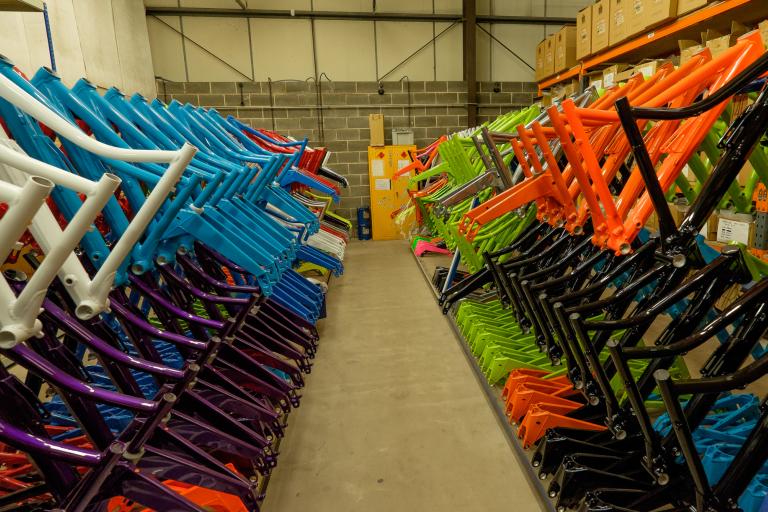
“This is not the end for Orange Bikes”: Popular mountain bike manufacturer releases statement after filing notice of intention to appoint an administrator
Four days after the news broke that pioneering mountain bike manufacturer Orange Bikes has filed its intention to appoint an administrator – a development itself emerging just weeks after the company’s racing team was wound down, citing the current “uncertainty” in the bike industry – the Halifax-based brand this morning a released a statement on Linkedin, assuring customers that “this is not the end for Orange Bikes”.
“We appreciate all the kind words and encouragement we’ve received from our loyal customers and fans. It’s heartwarming to see the continued support and passion for Orange Bikes,” the statement said.
“While we can’t provide many details at the moment, we want to assure you that this is not the end for Orange Bikes.
“We are committed to delivering high-quality bikes and maintaining our strong presence in the industry. Thank you again for your support, and stay tuned for more updates from Orange Bikes.”
> Orange Bikes - the story of Britain’s most iconic bike brand
10 January 2024, 14:54

Julian Alaphilippe set for Giro d’Italia debut this season – and confirms he will miss the Tour de France
While most of the focus come May will be on Tadej Pogačar’s first crack at the Giro d’Italia, as the Slovenian aims to secure the first Giro-Tour double for 26 years, another one of the sport’s biggest names is also set to make his Corsa Rosa debut this year: Julian Alaphilippe.
In an interview with L’Équipe ahead of the Tour Down Under, the two-time world champion confirmed that he will target stage wins at the Giro this year, after a spring campaign focused on Strade Bianche, Milan-Sanremo, and the Flemish classics, as part of his desire to “change” things up.
(Alex Broadway/SWpix.com)
However, the 31-year-old’s revamped schedule means he won’t be lining up in Florence for the start of this summer’s Tour de France and will therefore miss out on Soudal Quick-Step teammate Remco Evenepoel’s long-awaited debut at the race.
“It’s by no means a punishment or a non-selection,” Alaphilippe said of his decision to target the Giro rather than ride in support of Evenepoel’s GC hopes at the Tour. “Doing the Giro has been at the back of my mind for some time now.
“The question was more to do with ‘when shall I decide to go?’ and I thought ‘why not this year? Looking at [races in] Australia, the classics, and the Giro, I felt like a change.”
(Cor Vos/SWpix.com)
The flamboyant Frenchman – who counts six stage wins, a mesmerising spell in the yellow jersey, and a King of the Mountains title among his list of successes at the Tour – also said that when he suggested the idea of racing the Giro to Patrick Lefevere, the team boss agreed, apparently claiming that he did not want to see Alaphilippe sacrificing his Tour de France by riding purely in the service of Evenepoel.
“It’s neither my remit nor my full worth to do that,” Alaphilippe said, before noting that he would have had no problems working for Evenepoel – as he did during the Belgian star’s successful tilt at the Vuelta in 2022 – and that the decision was based purely on a desire to streamline the team’s goals in both races.
“It’s my decision,” he insisted. “I designed my programme and it was confirmed by the team so that way we’d go for stage wins in the Giro and then the GC [with Evenepoel] in the Tour.”
10 January 2024, 14:24
‘Alright Pogi, can we just make it through one training camp ride without you popping a wheelie and dropping us? Cheers mate’
Pogacar sendo Pogacar pic.twitter.com/RiBXrA11oO
— O País Do Ciclismo (@opaisdociclismo) January 9, 2024
Rumours that Pogačar is intent on wheelieing his way around the Giro d’Italia this year remain unconfirmed.
10 January 2024, 13:42
“Crackpot conspiracy theory” led to government slashing active travel funding
A “crackpot conspiracy theory” that misrepresents the urban planning concept of the 15-minute city led to the government slashing funding for active travel and pledge to review measures aimed at curbing the use of private motor vehicles, it has emerged.
The Guardian’s Peter Walker reports that documents obtained by the Transport Action Network (TAN), which has brought a legal challenge to the swingeing cuts imposed by Chancellor of the Exchequer Jeremy Hunt last year, reveal that conspiracy theories were partly responsible for the change in tack by the government.
Criticising the “absurdity” of ministers being “swept away by hysteria about 15-minute cities, at the same time that other government departments were defending them”, TAN’s director Chris Todd noted that the “shocking revelations show Rishi Sunak was more concerned with crazy conspiracy theories than helping people travel safely and cheaply”.
Read more: > “Crackpot conspiracy theory” led to government slashing active travel funding
10 January 2024, 12:44
No, I don’t know what’s going on at Groupama-FDJ’s team presentation either
#CyclismActu : à la prez de l’equipe @GroupamaFDJ avec ses 5 leaders 😇🚴🏻♂️
A retrouver sur https://t.co/hItDtvxPXA / @CyclismActu #GroupamaFDJ #Madiot #Madouas #Gregoire #Martinez #Gaudu #Kung #Cycling #Cyclisme #TDF2024 #Giro #LaVuelta pic.twitter.com/qQuDrUCSez
— Cyclism'Actu (@cyclismactu) January 10, 2024
Ah, professional cyclists, always the most fashionable and smooth of sporting stars. That snazzy blazer, white t-shirt, jeans, and white trainers combo – a very French chef’s kiss.
Though surely they could have managed to put together a stage big enough for a handful of spindly climbers and Marc Madiot? Or make sure their new Wilier bike could stand up on its own without the help of Stefan Küng? And why did it take place in what appears to be the abandoned basement of a new university? So many questions…
10 January 2024, 13:12
What were the best road and gravel wheels of the year, I hear you ask? Well, wonder no more, as the road.cc Recommends Awards committee has all the answers…
10 January 2024, 11:45
“This is enabling active travel”: Council praised for swift clean-up of flooded bike routes
HUUUGE thank you to @myworcester @MalvernHills_DC and @WorcsTravel for the prompt cleaning of the paths following the recent floods, notably riverside and Hams Way Bridge.
This is enabling active travel.
@activetraveleng
https://t.co/5qkehL8ivQ— SHIFT (@goSHIFTscheme) January 10, 2024
While last week’s live blogs tended to focus on the slow, lethargic response from some local authorities when it came to dealing with the plethora of flooded cycle routes across the UK, over in Worcester – where one cycle path is under water an astonishing 20 days a year on average, according to the local cycling campaign group – the council has earned praise for its swift clean-up operation.
According to Bike Worcester, last week’s Storm Henk-induced bike path cleaning took place “just hours” after the roads were dealt with, and the group’s chair Dan Brothwell tweeted this morning: “HUUUGE thank you to Worcester City Council, Malvern Hills District Council, and WCC Highways for the prompt cleaning of the paths following the recent floods, notably riverside and Hams Way Bridge.
“This is enabling active travel.”
Nevertheless, despite the good reactive work from the council, Bike Worcester also noted that “while the routes are great for a safer route from the south of the city, they're the first to close when floods occur.
“If Worcester City Council are to meet the aims of their ambitious Active Travel Plan by 2030, we need better infrastructure that doesn’t spend so much time underwater.”
But at least cleaning the paths is a start I suppose…
10 January 2024, 11:19
Now That’s What I Call a Cycling Kit: Canyon-Sram unveil the jersey of the year
10/10. No notes.
And, thankfully, no boring, indistinguishable-from-a-helicopter blue and white variation (I’m looking at you, Bahrain, Decathlon, Soudal Quick-Step, Israel-Premier Tech, Alpecin, Jayco, Groupama-FDJ, Movistar – I’m sure Rob Hatch is buzzing at the prospect of telling all those teams apart…).
Instead, Canyon-Sram’s look, as ever, is what all cycling kits should be – bold, brash, and cool. Oh, and with black shorts, too.
10 January 2024, 10:36

Mountain biking in national park “condemned”, as “disrespectful” cyclo-tourists have their bikes confiscated while riding on restricted trail
Over in New Zealand (like Scotland, but further), two Swiss cyclists have been criticised for “disrespecting” the fragile environment and cultural significance of the country’s Tongariro National Park, after they were filmed riding their mountain bikes through the restricted Dual World Heritage site.
Located in the central North Island, the Tongariro National Park is the oldest national park in New Zealand and includes three active volcanoes and a number of religious sites sacred to the Māori people. Under the park’s laws, it is an offence to use any vehicle, including bikes, off-road in the park.
But in November, two Swiss tourists were filmed by bemused hikers on the Tongariro Alpine Crossing – deemed one of the world’s best one-day hikes – riding their mountain bikes through the park.
The oblivious tourists’ bikes were subsequently confiscated by the Department of Conservation (DOC), who returned them after the weekend, and the pair were fined $400 each, reports Stuff.
DOC Tongariro operations manager George Taylor told reporters that to get to the point where they were filmed, the cyclists had to pass signs warning mountain biking was not permitted in the area, as well as climbing hundreds of steps and pass numerous walkers, while not encountering any other person on a bike.
Taylor also said their ride was “an affront to those working to protect the fragile environment and cultural significance” of the Crossing, and that they “deliberately disregarded the rules and clear communication of those”.
“Bicycles on walking tracks can damage sensitive alpine environments, present a safety risk to trampers [hikers], and are generally disrespectful of this taonga national park,” he said.
The DOC added that the tourists booked their trip through the crossing and would have “received confirmation emails containing safety and cultural information to perhaps avoid their embarrassing mistake”.
Ngāti Hikairo ki Tongariro spokesperson Te Ngaehe Wanikau added: ““The use of mountain bikes on a track created solely for pedestrian use, places both the users of the crossing, and the unique environment of Tongariro at risk.
“Ngati Hikairo ki Tongariro condemns mountain biking and any other non-pedestrian activity compromising the safety and well-being of people and Tongariro.”
10 January 2024, 10:25
Your morning Near Miss of the Day
For those perpetually perplexed drivers, such as this morning’s batch of Cycleway 4 etiquette critics, still struggling with the difference between being ‘close passed’ by a cyclist and a motorist, here’s a handy reminder…
Read more: > Near Miss of the Day 886: Fast close pass at pinch point – but driver only gets warning letter due to stretched police resources
After obtaining a PhD, lecturing, and hosting a history podcast at Queen’s University Belfast, Ryan joined road.cc in December 2021 and since then has kept the site’s readers and listeners informed and enthralled (well at least occasionally) on news, the live blog, and the road.cc Podcast. After boarding a wrong bus at the world championships and ruining a good pair of jeans at the cyclocross, he now serves as road.cc’s senior news writer. Before his foray into cycling journalism, he wallowed in the equally pitiless world of academia, where he wrote a book about Victorian politics and droned on about cycling and bikes to classes of bored students (while taking every chance he could get to talk about cycling in print or on the radio). He can be found riding his bike very slowly around the narrow, scenic country lanes of Co. Down.
Latest Comments
- brooksby 8 min 7 sec ago
All those photos of Concerned Locals™ - surely a good moment for local cyclists to ride past, ideally in primary position?
- brooksby 10 min 25 sec ago
Given that it is trying so hard to be really very modern and hi-tech, I'm sure that there would have been a better way of sorting out braking on...
- Secret_squirrel 13 min 3 sec ago
Really? Jerkish comment - we don't have to drag the teumpiean clusterfuck into everything you know.
- Rendel Harris 32 min 53 sec ago
Not as far as I'm aware, his response was “Frankly, they need better dirty tricks. The ‘everyone is Hitler’ attack is soo tired.” - which is...
- mdavidford 49 min 55 sec ago
I would assume there's some kind of transmission in this bit. Don't know about a 'clunk' though - if it's capable of mimicking all kinds of gear...
- HollisJ 1 hour 22 min ago
Weird. I went there a few weeks ago and all I saw was a cycle lane and plenty of free parking provision next to it, no keeerrraazy wiggly lines....
- chrisonabike 2 hours 59 min ago
I suspect a different poster - our consistently unlucky (yet somehow surviving) wheelchair user never had anything good to say about cyclists!
- Rendel Harris 3 hours 36 min ago
That's a very good point, I remember once speaking to somebody who had volunteered in Gaza as a medic who said that the vast majority of the...
- OldRidgeback 4 hours 7 min ago
It isn't the first time BC has avoided sending riders to events, even when there have been riders with potential.



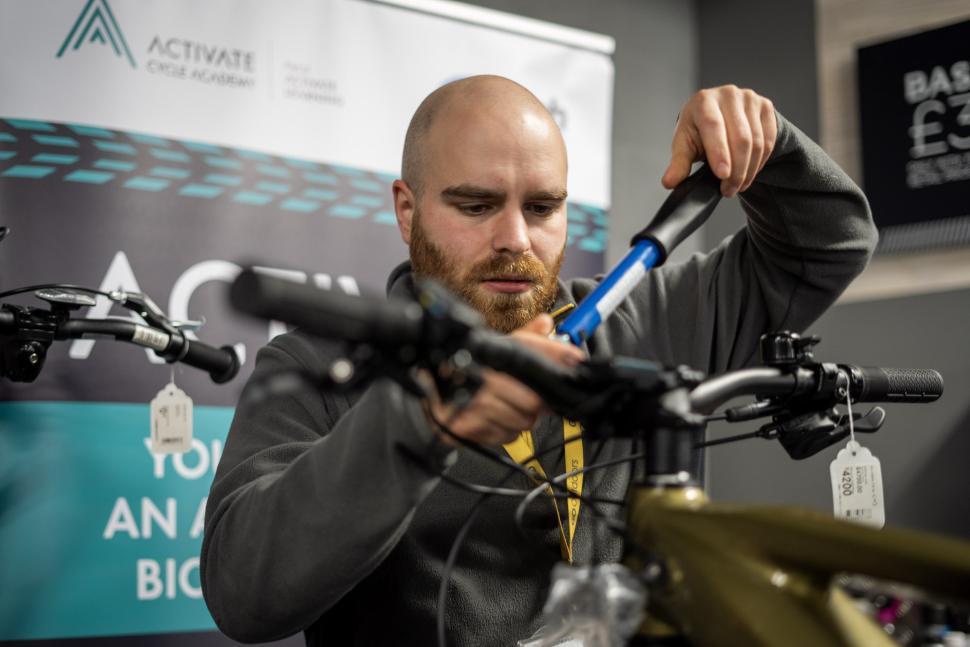


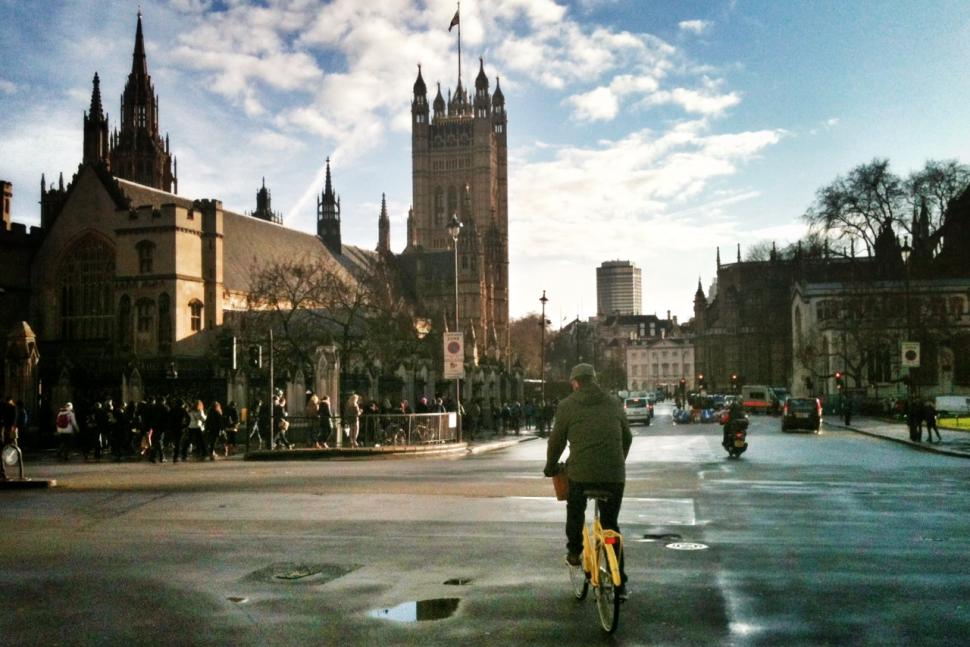
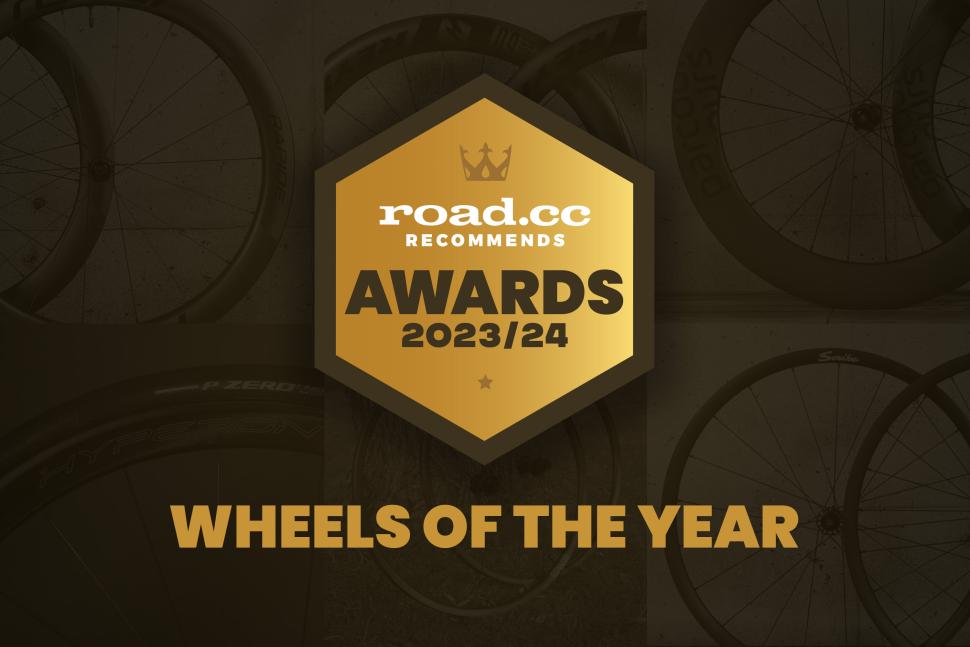

Add new comment
69 comments
Tom tom need to go drive in manila. Then complain about long journey tiems.
Took 3hrs to do the a 12mile trip there once.
"“Oh yes indeed passing the cyclists decked out in black, they’ll be finishing work before it gets dark,” Nigel chipped in with the obligatory dark clothing remark."
Bit ironic that one, given that when it is dark the colour of your clothing doesn't matter a bit. Black, white, blue, yellow, polka dot - doesn't make a blind bit of difference because.... it's f'in dark. Lights and reflectives are the relevant factors in the dark - and can make you far more visible at night while wearing an all black ninja suit than you would be in a hi-vis workman's jacket during the day.
Is there even a proper definition of what Hi-Viz is in a cycling context? Hi-Viz in snow is black, in the dark, reflective (or very light), in the countryside, multi-colour but not green-based.
I'm wondering if Tom-Tom have bought into the crackpot theories about 15 minute cities or whatever. Or perhaps they're just short of publicity and think that being disingenuous will endear them to drivers. Well it might, but only the stupid ones.
15-minute city pioneer Carlos Moreno announces he’s set to lecture at Oxford University on the controversial and misrepresented urban planning concept
I'll be sending that to my MP, Mark Harper, suggesting that he attends: he really needs educating on his brief.
I reckon about half the road space in London is used to store empty cars, and most of what is left has one person per car traffic taking up most of the road space. The problem of low traffic speeds in London is caused by too many cars - not 20 mph speed limits.
What is really striking walking back through somewhere like Kensington is just how many cars parked on London streets haven't moved for months. Cars don't go green and slimy in a few weeks.
“This is enabling active travel”: Council praised for swift clean-up of flooded bike routes
"Nevertheless, despite the good reactive work from the council, Bike Worcester also noted that “while the routes are great for a safer route from the south of the city, they're the first to close when floods occur."
The bike paths are close to the river Severn where further upstream numerous areas of flood plains have been built on and flood barriers push more water dowwnstream. Not easily going to stop it from happening.
The idea that recent housebuilding and the flood barriers in places like Shrewsbury and Ironbridge are making the problem in Worcester much worse is incorrect. There is virtually no housebuilding on the floodplain areas that could (and do) ease the problem. The barriers protecting vulnerable locations don't make any difference to river levels further downstream. Look at the vast area submerged at Melverley last week, to name just one of several floodplains:
https://twitter.com/ShropshireMatt/status/1743250491314733508/video/1
The issue is that the bike paths are placed beside or close to the longest river in the country, which is flooding and more and more frequently with the trend towards milder, wetter winters.
I can't work out if these people are stupid, WUMs, or genuine - certainly ignorant of the HC.
https://twitter.com/stuartj0hnson/status/1744619650107723837
Loads of comments about there being enough room and it was easily 1.5m
Oh and "The bike in front needs to get in more!"
They must hit a lot of parked cars as they clearly can't judge distance.
I think I made a similar comment during the pandemic. If drivers think that's 1.5m how will advising them to keep 2m social distance actually help contain Covid.
If drivers think that's 1.5m how will advising them to keep 2m social distance actually help contain Covid
This nutter BMW driver of PK14 HLW had learned the number, but didn't think it actually applied. He said 'I gave you 1.5 metres', along with threatening to 'knock me off' and 'fucking flatten me'. After much effort by me, the police were eventually persuaded to 'have a word with him', but that was only for the threats. The close passing was ignored.
“Yes and, er, no,” road safety guru Bob Davis replied. “The only people I have known who went out with uncovered knees at temperatures below 5 Centigrade developed knee problems.”
I was actually lectured on this subject (knee pronblems) by an old pro I cycled with on a cold April morning. He actually said that just because it was Spring didn't mean that I should have my knees out on a "training ride". He actually set the temp at 15°C. I did go and buy some knee warmers and I still pretty much stick to this advice.
I've always been a reluctant knee uncoverer - my personal theory being that knees need all the tlc they can get. Interesting to see someone else loves knees too.
Was given the same advice for when training (or just bimbling), 'below 15 degrees, cover the knees'
"According to TomTom’s analysis, journeys of 10km in central London took an average of 37 minutes and 20 seconds last year"
Considering a lot of cyclists could do 10km in less than 30 minutes even in a city environment on flat terrain, the answer is glaringly obvious, and yet nobody sees it.
Also, 10km in 37 minutes is approx 10mph so how would increasing the limit from 20 to 50 mph help if they're not going anywhere near 20mph anyway?
But if there was a highway through the centre of the city which cut the place in two, caused a lot of noise and pollution and allowed people to easier avoid visiting the parts of the city which actually make money the speed of cars would be increased and that would be a good thing...for some reason.
Right. "I can't average more than 10 MPH because the speed limit is 20, not 30 or 50" is all kinds of stupid.
I think the biggest thing is how, in the context of the city being a prosperous, pleasant, human place to live, higher average speed of car traffic is actually a bad thing. Nobody looks at the side of a motorway and thinks, "man, I wish I had a house on the hard shoulder and I could open a shop there!" Being able to drive through a city quickly is only useful if you don't want to stop there.
https://metro.co.uk/2024/01/10/gran-sending-christmas-cards-killed-drive...
That is yet another travesty. Lots to hate about this, but the nissan navara is certainly right up there.
Mrs HawkinsPeter and I did the Tongariro Alpine crossing a few years ago - it's a tough walk and definitely not suitable for bikes. The weather itself is a challenge as you need to be prepared for hot and sunny at the low levels and freezing winds at altitude. We chose to do it as Mrs HawkinsPeter was enamoured by the Emerald and Blue Lakes, but once we got up to altitude where you get all the magnificent views, the fog descended and we could see nothing. Luckily, there's so many tourists going along there, that you can just follow everyone else and don't need to see where you're going.
Ther bikers must have been determined as there's so many warning signs along the route - they mostly detail how many hours walk it is to get to the end and recommend turning back if you are struggling at all as once you get around half way, there's no turning back and nowhere for helicopters to land to rescue you.
Like many drivers.
it's a tough walk and definitely not suitable for bikes
These cyclists were definitely in the wrong, but sometimes a man's gotta do what a man's gotta do, and 'not suitable for bikes' is a good challenge when nothing's being damaged. It was a 6 hour carry up the snowfields to the Theodulpass from Zermatt on the crossing to Cervinia. You're overlooked by the cablecar to the Klein Matterhorn, and jeered at by the occupants (I recall being sure at the time that it was jeering rather than cheering).
A bit of (half hearted) defence of Tom Tom.
The blaming 20mph zones is plain weird, especially when the average speed is so far below 20mph. (I think they point to the average speed getting slower, but then they also say that's true for most cities.)
However, on the 50mph point, I think they are just making the comparison with other cities - they do say that London doesn't have the infrastructure for driving quickly.
And, most positively, their actual recommendation is "At the same time, local authorities must put support behind programmes that encourage cycling, public transport and other modes to take a larger share in transportation.”
Other cities? Motor-normative cities like Houston I suppose.
"London is world's slowest city for drivers, study finds"
No mention of how this compares to previous years (prior to implimentation of 20mph limits).
Nor any consideration given to traffic volumes which have been seriously affected by private hire vehicles and online deliveries.
(Though I'm glad to see smaller bicycle based delivery vehicles becoming more common.)
Or the fact that so many cars on the road now are larger than before (ie SUVs) which are difficult to drive in small spaces and mean other drivers may not be able to squeeze past.
https://www.bbc.co.uk/news/uk-england-london-67916773
Bristol is fourth slowest in the UK: https://www.bristolpost.co.uk/news/bristol-news/bristol-one-slowest-cities-uk-9022893
After a bit of internet sleuthing, I've found that the data comes from TomTom
https://www.tomtom.com/newsroom/explainers-and-insights/tomtom-traffix-index-2024-london-is-slowest/
It's just a publicity stunt - the numbers are pretty much meaningless.
That said, the actual report does make some reasonable points, such as comparing London to Amsterdam and suggesting that Amsterdam achieves a better score (less congestion) precisely because it has excellent active travel and public transport and therefore far fewer cars on the road.
Which is of course what the evil cycling lobby has been saying all along - providing viable alternatives to driving actually makes driving easier and faster for those who really need to do so.
Pages